Soapbox
To mark the anniversary of 125 years of women’s suffrage in New Zealand, Auckland Council commissioned three artworks on three sites. Two are by artists: Jae Kang’s Mahi Tahi in Pukekohe and Erin Forsyth’s Kid Justice in Howick. The third is the most recent to be unveiled, if that’s the word, but ‘launch’ is more appropriate as it is a spatially dynamic work by a team of architects, designers and graduates.
Soapbox was created by Olivia Collinson, Vanessa Coxhead, Stephanie Darlington, Prue Fea, Jayne Kersten and Madeleine Racz, in collaboration with architecture firm Jasmax. It references the old soapbox on which speakers could stand to address gatherings and the persuasive speaking skills of suffragist leader Kate Sheppard, in particular, but it’s more than a simple stage.
As Stephanie Darlington puts it: “Rather than an impromptu act on a makeshift platform, this evolution references the considered and articulate public speeches of the suffragettes in favour of the women’s vote.”
Each of the three sites Council put forward for this commemorative programme involved a similar two-metre-square base, suggestive of a vertical structure, but the Soapbox team, in responding to the call for expressions of interest, was attracted to this sloping site on the shore of Lake Pupuke. Rather than a static object, the group has created something more plane than plinth; its angular form and pitch are suggestive of take-off into the blue. There is a strength and directionality about Soapbox that’s less sombre and reflective than are most memorials: more of a call to action.
It is not simply a sculpture to look at; it is also a springboard, an object that we can engage with physically. It is less an artwork, more an architectural form that enables activity. I was lucky enough to see it in full flight at the opening when several performers used it, but it was also a magnet for others, young and old to climb aboard.
And it doesn’t just work as a means to pull a crowd; it is also a contemplative spot on which to stand for the solitary stroller. Prue Fea explains: “By creating a raised platform from which to view the lake, we want people to feel empowered and to take a long view of history – one that encompasses the past and future generations. We believe that the voices of women and indigenous people are critical in shaping the future of a sustainable world.”
Architects are good at public art. Artists do research but those working in the area of built environment design are especially good at responding to physical, environmental and historical context in order to generate an appropriate formal response that is layered with meaning. Soapbox’s red-oxide-tinted, glass-reinforced concrete construction marks it as a thing of the land and contrasts with the green setting, but is also a nod to the brick of the PumpHouse Theatre nearby and the red scoria of Auckland’s volcanic geology.
Its surface includes a zigzag pattern, which could be stylised ripples or feathery wings expanding out along the length of the structure, reinforcing that notion of forward movement and progression. The designers say this repetitive pattern (and weaving has been customarily associated with women) speaks of the convergence of many voices and the work of all those in the women’s movement to achieve the goal of suffrage. They also make reference to Hineahuone of Māori myth: the first woman, formed from earth.
I was somewhat surprised to learn that these works will stand for only five years before being replaced by new ones. I suppose that’s appropriate. Although the suffrage struggle has been won, in that women have the vote, the fight for equality in the workplace and daily life goes on.
The temporary nature of these artworks means that another group of women will, in a few years, have the opportunity to have their say in a new generation of commemorative artworks. That means the current crop will be looking for new homes but, since Soapbox is proving its usefulness as a platform for performing artists and political voices, I’m sure it will resume its role when, no doubt, it lands in another part of the city.
This article first appeared in Architecture New Zealand magazine.











